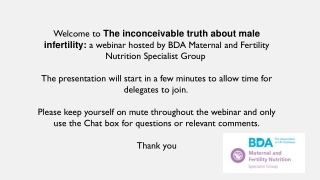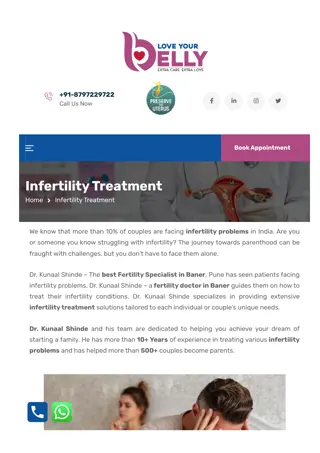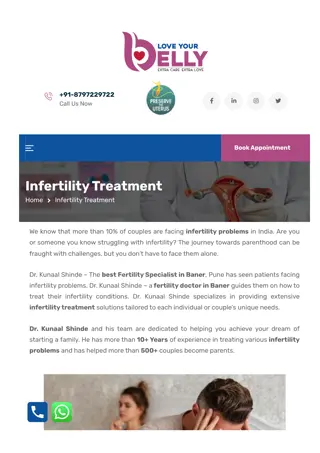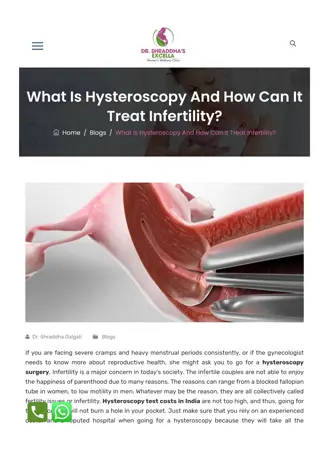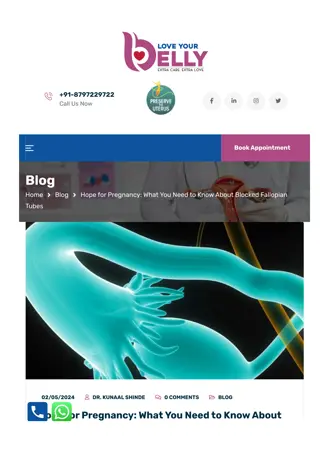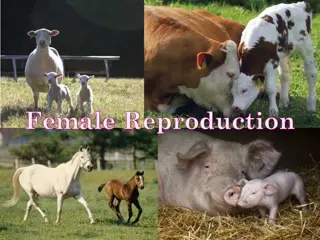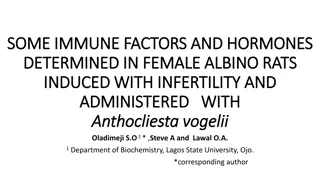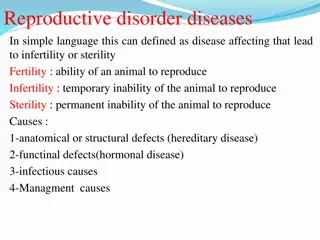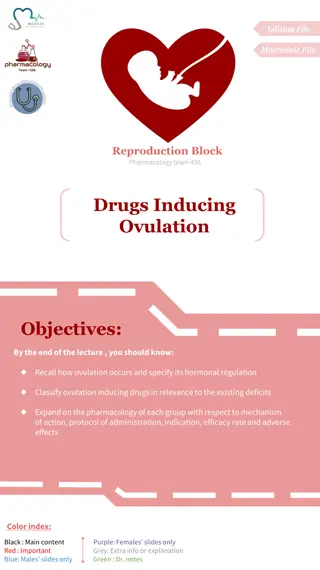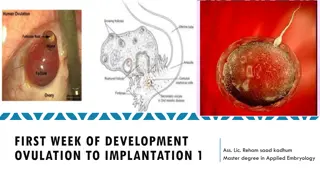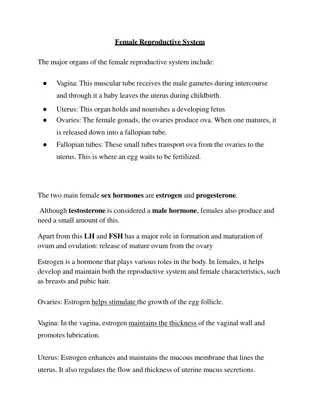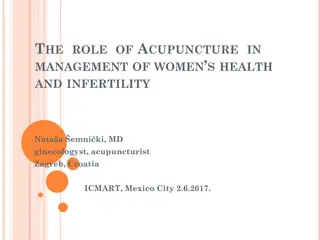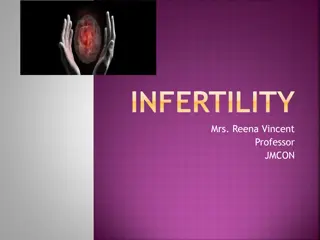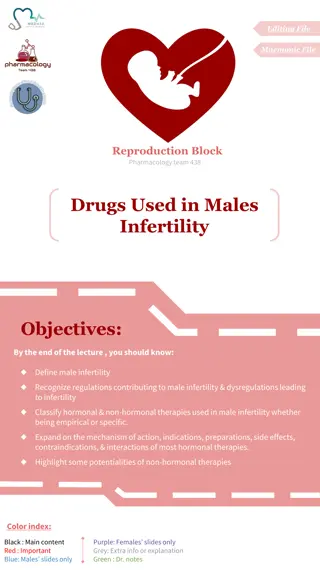Ovulation Induction Drugs and Female Infertility
In this lecture, learn about ovulation and its hormonal regulation, causes and types of female infertility, and ovulation-inducing drugs. Dive into the pharmacology of these drugs, including mechanism of action, administration protocol, efficacy rate, and adverse effects.
Download Presentation

Please find below an Image/Link to download the presentation.
The content on the website is provided AS IS for your information and personal use only. It may not be sold, licensed, or shared on other websites without obtaining consent from the author.If you encounter any issues during the download, it is possible that the publisher has removed the file from their server.
You are allowed to download the files provided on this website for personal or commercial use, subject to the condition that they are used lawfully. All files are the property of their respective owners.
The content on the website is provided AS IS for your information and personal use only. It may not be sold, licensed, or shared on other websites without obtaining consent from the author.
E N D
Presentation Transcript
By the end of this lecture you will be able to: Recall how ovulation occurs and specify its hormonal regulation Recognize causes and types of female infertility Classify ovulation inducing drugs in relevance to the existing deficits Expand on the pharmacology of each group with respect to mechanism of action, protocol of administration, indication, efficacy rate and adverse effects.
Primordial Follicular Phase Recruitment Gn-independent Pry 3 3- -7 d 7 d Sec Selection Gn-responsive Little estrogen Preantral 13 cycles / year Antral between puberty & menopause 7/8 12 d 7/8- -12 d Dominance=Maturation Hormone-dependent High estrogen A Fertile; ovulates 400 in life Graffian Follicle 12 12- -14 d LH > FSH SURGE 14 d OVULATION
A condition characterized by a reduction in ability to reproduce or to achieve conception Endometriosis Tubal causes, blockage or damage 1/3 attributed to women. 1/3 attributed to male factors 1/3 both or unexplained Fibroids Polycystic Ovarian Syndrome Miscarriage Common cause of female infertility Most common cause of female infertility Failure of Ovulation
Hyperprolactinaemia Hypogonadotropic Hypothalamus GnRH Anterior Pituitary FSH / LH Ovary Estrogen Progestins ANTIESTROGENS D2 R Agonists Hypothalamo-pituitary Bromocreptine SERMs; Clomiphene Tamoxifen GONADOTROPHINS HMGs;Menotropin HCGs; Pregnyl GnRH GnRH-agonists Leuprolin Goserelin (-) (-) IN POLYCYSTIC OVARIAN SYNDROME [Most common cause of infertility] Insulin resistance ??? Give METFORMIN; body weight & response to ovulation induction drugs Ovarian Normogonadotrophic Hypergonadotrophic Conception remote, no place for therapy
ANTIESTROGENS SERMs Selective Estrogen Receptor Modulators [SERMs] compete with estrogen on estrogen receptors in the nucleus Doing so they act as antagonists or partial agonists depending on how they bind & the different target tissue of action. In the hypothalamus & pituitary they have ANTAGONISTIC ACTION
ANTIESTROGENS SERMs Hypothalamus GnRH Anterior Pituitary 1. CLOMIPHENE Pharmacological effects On hypothalamus; back of endogenous estrogen on hypothalamus pulse GnRH gonadotrophin production [FSH & LH] cause growth maturation & rupture of follicles OVULATION Estrogen Progestins gonadotrophins to GnRH Indication negative feed Clomiphene FSH / LH (-) Ovary On pituitary; response of Female infertility; not due to ovarian or pituitary failure Normogonadotrophic The success rate for ovulation 80% & pregnancy 40% .
CLOMIPHENE cont. ANTIESTROGENS Method of administration SERMs Coitus every day/other day Clomiphene given 50 mg/d for 5 days from 5th day of the cycle to the 10th day. If no response give 100 mg for 5 days again from 5th to10th day The drug can be repeated not more than 6 cycles . 5 days5 days 7 days Clomiphene 50-100 mg/d Progesterone LH FSH 2 4 6 8 1012141618202224262830 Menses ADRs 1.Hot Flushes & breast tenderness 2. Gastric upset (nausea and vomiting) 3. Visual disturbances (reversible) 4. nervous tension & depression N.B. incidence of multiple ovulation twins in 10% birth 5. Skin rashes 6. Fatigue 7. Weight gain 8. Hair loss (reversible)
ANTIESTROGENS 2. TAMOXIFEN SERMs Is similar & alternative to clomiphene But differ in being Non Steroidal Used in palliative treatment of hormone-dependent / estrogen receptor- positive advanced breast cancer But why clomiphene not used in such cases of cancer breast?
GONADOTROPHINS [FSH & LH] Are naturally produced by the pituitary gland For therapeutic use, extracted forms are available as; 1. Human Menopausal Gonadotrophins (hMG ) extracted from postmenopausal urine contains LH & FSH MENOTROPIN 2. Human Chorionic Gonadotrophins (hCG) extracted from urine of pregnant women contains mainly LH) PREGNYL N.B. Now new available preparations by recombinant technology Mechanism Preparations of FSH act on ovary directly, stimulating growth & maturation of Graafian Follicle(s) Preparations of LH act just to induce ovulation Given sequentially Indication Stimulation & induction of ovulation in infertility 2ndry to gonadotropin deficiency (pituitary insufficiency)
Success rate for inducing ovulation is usually >75 % GONADOTROPHINS [FSH & LH] Method of administration hMG is given i.m or subcut. every day starting at day 2-3 of cycle for 10 days followed by hCG on (10th - 12th day) for OVUM RETRIEVAL within 36 hrs. When we indicate: intrauterine insemination or intercourse ADRs FSH containing preparations; Fever LH containing preparations; Headache & edema Ovarian enlargement (hyper stimulation) Multiple Pregnancy (approx. 20%)
GnRH native-Gh RH GnRH-Agonist LEUPROLIN GOSERELIN Mechanism Native GnRH is naturally produced by hypothalamus in a pulsatile manner. It is triggered when the negative feedback inhibition of ovarian hormones is lost by the end of the cycle. This activates FSH release from pituitary that stimulate growth and maturation of ova early during the follicular phase of the cycle. It also mediates estrogen induced LH surge that triggers ovulation. GnRH-Agonists bind to the receptors & mimic the native hormones provided it is given PULSATILE
GnRH If PULSATILE Mimic native GnRH LEUPROLIN GOSERELIN If CONTINOUS Block GnRH Receptors GnRH-Agonist GnRH-Agonist GnRH In cancer (prostate & breast) & other long term indications as precocious puberty, endometriosis & fibroids Intranasal, injectable & implant formulations Pulsatile Continuous FSH & LH GONADAL ACTIVATION Growth maturation & rupture OVULATION INDUCTION
GnRH Uses In OVULATION INDUCTION per se LEUPROLIN GOSERELIN In hypothalmic amenorrhea (GnRH deficient) pulsatile S.C. or drip (1 10 g / 60 120 min) GnHs release Start from day 2-3 of cycle up to day 10 OVUM RETRIEVAL After 36 hrs In ASSISTED REPRODUCTION is part of a protocol for OVUM RETRIEVAL ADRs GIT disturbances, abdominal pain, nausea .etc Headache Hypoestrogenism on long term use Hot flashes Osteoporosis Rarely ovarian hyperstimulation (ovaries swell & enlarge) Vaginal bleeding Libido
D2 R Agonists Is an ergot derivative. BROMOCREPTINE Bromocreptine Mechanism D2 R Agonists bind to dopamine receptors in anterior pituitary -ve PRL secretion Indications Female infertility 2ndry to hyperprolactinaemia ( hypogonadotrophic) ADRs GIT disturbances; nausea, vomiting, constipation Headache dizziness & orthostatic hypotension Dry mouth & nasal congestion Insomnia No Ovulation Hyperprolactinaemia
L L G G U U O O C C O O K K D D


